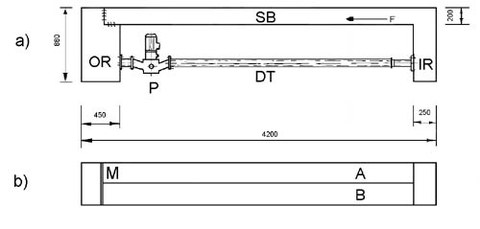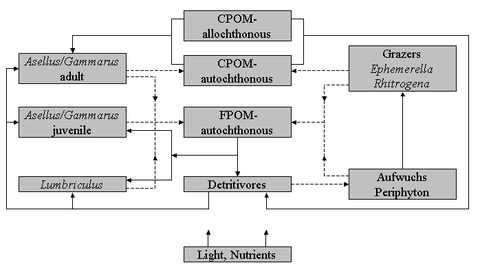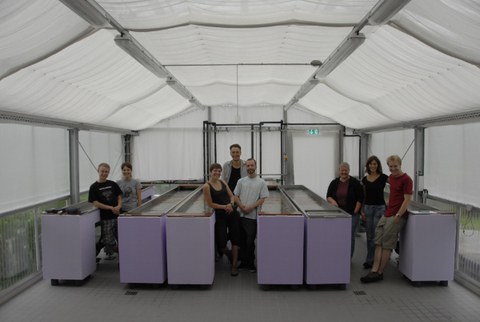Artificial Indoor Streams
The hazards of chemicals on aquatic communities are basically evaluated by standardised single-species bioassays. The assessment is based on results gained from organisms adapted to lentic systems and biological interactions in ecosystems are neglected in these tests. While lotic communities are often at first in contact with chemicals, it is astonishing that mainly microcosms with lentic communities are used as a bridge between laboratory bioassays and outdoor aquatic systems. Hence, six artificial indoor streams are established in a greenhouse of our institute.
The technical construction enables a water velocity of approximately 0.5 m/s and a constant water temperature of 6 to 20 °C. The artificial indoor streams can be used to investigate the effect of chemicals (5 concentrations + control) on a lotic community.

An assembly drawing of an artificial indoor stream a) - side view: OR - outflow reservoir, IR - inflow reservoir, SB - stream-bed,F - direction of flow, P - pump, DT - double coated tube b) - top view: A and B indicate the two channels, M - mesh to separate the channels and the outflow reservoir All measurements in millimeters
The aim of the approach is to investigate besides direct effects of chemicals indirect effects on interactions (predator - prey; competition). Therefore, a lotic community was established in the artificial streams which is quite simple, however, the populations dynamics of each member is well known. Experiments performed within the streams used aufwuchs from local streams as basic trophic level as well as additional coarse POM e.g. from Elder (Alnus glutinosa). As consumer different aufwuchs grazers like mayfly larvae (Rhithrogena semicolorata, Ephemerella ignitia) or snails (Potamopyrgus antipodarum) were used. Furthermore, the community consists of detritus feeders like Lumbriculus variegatus and shredder like Gammarus fossarum or Asellus aquaticus.

Scheme of the food web under investigation in the artificial indoor streams. Solid lines indicate energy flow and the broken lines indicate the results from action of the organisms or physical processes.
The abiotic conditions in the streams are kept constant except the concentration of the chemical and the population structure at the beginning of the experiment is defined. This approach enables together with the mathematical modelling of the population the casual analysis of direct and indirect effects of chemicals on the community.
Further investigations will be carried out to enlarge the community so that the food web should include at least two organisms of each trophic level. The investigations are seen as a link between single-species-tests and freshwater field tests actually used for hazard assessment of chemicals. The former could not include interactions which took place in the natural environment. The latter are often experiments with a very complex community, and it is difficult to reveal clearly indirect effects which are assigned to the chemical.

